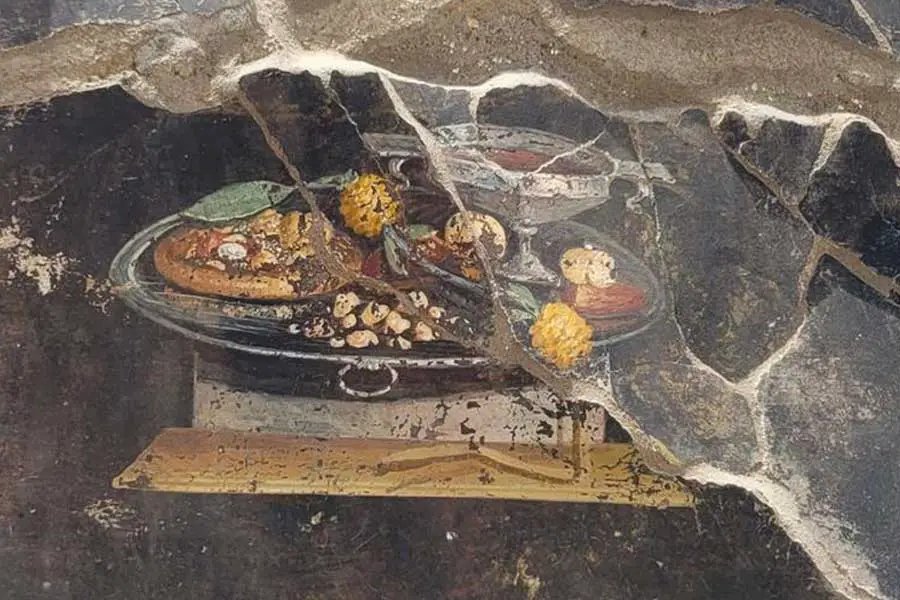In an exciting new discovery, a fresco unearthed in the ancient city of Pompeii may possibly portray a 2000-year-old variant of pizza. This revelation has sent ripples of excitement through both the archaeological and culinary communities.
Pompeii – A Historical and Archaeological Treasure
Pompeii, a city that was tragically engulfed by the eruption of Mount Vesuvius in 79 AD, stands as an enduring testament to the grandeur of Roman civilization. The city, preserved under layers of volcanic ash for centuries, offers a unique window into the daily lives, culture, and society of the Roman era.

Rich in history, Pompeii was once a bustling city with a thriving economy. It was home to approximately 20,000 inhabitants and was filled with a myriad of public buildings, homes, and marketplaces. The city’s inhabitants led lives not so different from ours today, with occupations ranging from merchants and politicians to artisans and farmers.
The catastrophic eruption of Mount Vesuvius froze the city in time, preserving a moment of everyday Roman life. Today, the city serves as a living museum, offering an unrivaled glimpse into the past. It’s one of the few places in the world where we can walk the same streets, enter the same buildings, and view the same art as people did over two thousand years ago.
The archaeological importance of Pompeii cannot be overstated. Since its rediscovery in the late 16th century, Pompeii has been a treasure trove for archaeologists. The city’s well-preserved structures and artifacts have provided invaluable insights into Roman architecture, art, commerce, and domestic life. Each new discovery, like the recently unearthed fresco, adds another piece to the puzzle of understanding our shared human history.
A Slice of History – Tracing the Origins of Pizza
Pizza, a beloved dish worldwide, has a rich and intriguing history that’s as layered as its toppings. Although pizza in its current form is relatively recent, the idea of topping bread with various ingredients dates back thousands of years across different civilizations.

The earliest precursor to pizza can be traced to ancient Egypt, where flatbreads were used as an edible plate for other food items. In ancient Greece, people enjoyed plakous, a flatbread topped with herbs, onion, cheese, and garlic.
However, the pizza we know and love today, with its characteristic combination of yeasted flatbread, tomato sauce, and cheese, is generally believed to have originated in Naples, Italy, in the late 18th century.
At that time, Naples was a bustling, densely populated city. Street vendors sold pizza as an inexpensive and convenient food for the working class. These early pizzas were typically topped with simple, readily available ingredients like tomatoes, cheese, oil, anchovies, and garlic.
The modern era of pizza began in the late 19th century with the creation of Pizza Margherita. According to popular lore, this pizza, adorned with the colors of the Italian flag – red tomatoes, white mozzarella cheese, and green basil leaves – was created in honor of Queen Margherita of Italy.
Since then, pizza has spread across the globe, evolving into countless regional variations. Whether it’s a deep-dish style from Chicago, thin-crust New York slices, or unique creations from Japan or Brazil, pizza’s versatility and universal appeal are undeniable.
Despite pizza’s diverse evolution, its core essence remains a simple, hearty dish that brings people together. The recent discovery at Pompeii, if confirmed to depict an ancient form of pizza, could add another fascinating layer to our understanding of this timeless culinary delight.
The Fresco at Pompeii
The fresco that has sparked off all this excitement seems to display a food item strikingly similar to what we know today as pizza. While the toppings are different to those we traditionally associate with pizza nowadays, there is no doubt that the finished product looks strikingly similar to this popular dish.
The fresco will undergo further analysis and it is likely that there will be heated debate as to whether the depicted food item truly represents an ancient version of pizza. Regardless of the outcome, this find is yet another testament to the rich and fascinating history concealed within the ruins of Pompeii.

